NauticalNotebook.com
© 2010-
Please contact us with any questions or comments
Ghosts of Our Liners Past
by Lisa Plotnick
Every so often, my thoughts often turn to liners that are no longer with us other than in my memories.
I am fortunate, as an ocean liner aficionado, that my passenger ship history includes five ocean liners. Only one of those is still around today (Queen Elizabeth 2), although her future has been in limbo since being withdrawn from service four years ago. The others have met their tragic ends, three at scrapyards and one by the might of the ocean. Guided by reviews I wrote shortly after our cruises and notes recorded in journals during the voyages, I recount some of our favorite memories of these four special ships.
SS SeaBreeze (1993, 2000)
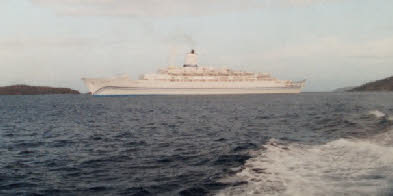
The Ship: She was built in Genoa, Italy in 1958 as the first newbuild for Costa Cruise
Line. As Costa’s Federico C, she spent her early years making regular journeys between
Italy and the eastern coast of South America, servicing passengers in three classes.
In 1983, after several years cruising the Caribbean, she was sold to Premier Cruise
Line, becoming the line's first ship, StarShip Royale. In 1988, she was purchased
by Dolphin Cruise Line, underwent extensive refurbishment, and was renamed SeaBreeze.
She cruised various Caribbean itineraries before returning to Premier as part of
the 1997 consolidation of Dolphin, Seawind, and Premier Cruise Lines. The 605-
Our cruises: We were onboard in March 1993 (Dolphin Cruise Line) for a seven-
Memories: On our 1993 cruise, I was three months pregnant but my husband and I had not told anyone at that point. Yet, it was a different story onboard ship. We shared the news excitedly with all who would listen. Our assistant waiter was one of them – when I sat down to dinner every evening, he had a tall glass of skim milk waiting for me. We were also celebrating a wedding anniversary and remember a wonderful party in one of the lounges with the cruise director and approximately a dozen other couples. When it was time to cut the cake, the cruise director asked for two couples – the one who had been married the longest period of time and the one who were married most recently. There was only one knife available, though, prompting the cruise director to quip, “we’re a small company.” As far as the ship, we were charmed by the labyrinthine corridors that seemingly went nowhere, the portholes in the cabins, and the single elevator (that didn’t go to all decks). Our cabin had no TV, offered three channels of radio, and had a shower pipe that came apart one afternoon, yet we loved it all. And the food! Extravagant midnight buffets every night!
Our 2000 cruise was like a return home. This time, we had our six-
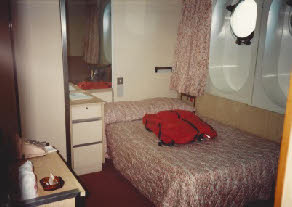

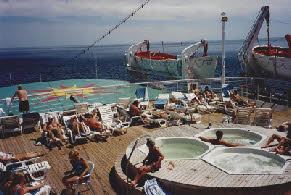
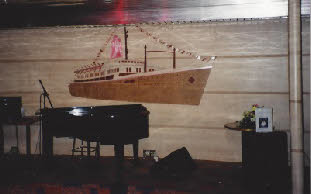
Top (1993): left, our cabin, F055; right, one of several nightly buffets
Bottom (2000): left, outer decks, aft; right, mural in Royal Fireworks Lounge, added after 1993
Her fate: Premier cruises ceased operations abruptly in September 2000 and her ships held in their final ports of call. In the case of SeaBreeze, this was Halifax, Nova Scotia. We were scheduled to embark her next cruise, a weekend cruise to nowhere that was to leave Boston the day after we learned of the news. SeaBreeze was reportedly sold to one of Premier’s creditors shortly thereafter and was on her way to an unknown destination when she was lost in heavy seas off of Virginia on December 17, 2000. The rescue of her remaining crew was captured by U.S. Coast Guard helicopter. In an odd twist, she was in view of my living room window for several hours on December 15 while in Boston for refueling. I truly felt it was her way of saying goodbye to me.
SS OceanBreeze (1996)
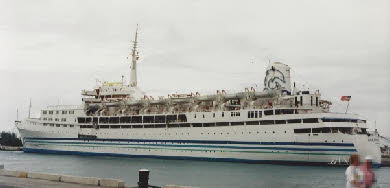
The Ship: SS OceanBreeze debuted in 1955 as Shaw Savill Line's Southern Cross and
was designed for around-
Our cruise: We were onboard in November 1996 for a four-
Memories: Our cruise on SS OceanBreeze coincided with a confluence of several late-
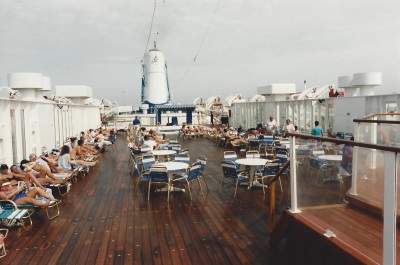

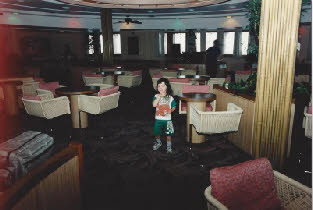
Top: Open deck atop ship
Bottom: left, our son dancing to the beat; right, Mayfair Lounge, containing original charm
Her fate: OceanBreeze was chartered to (and later purchased by) Imperial Majesty
Cruises in 1999 for two-
SS Norway (2001)
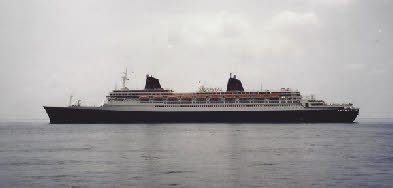
The Ship: Much has been written about the history of SS Norway, so I will keep details
to a minimum. She debuted in 1962 as SS France, the last passenger liner for the
Compagnie Generale Transatlantique (a.k.a., the French Line)—and was, according to
many ship historians, the last liner designed specifically and solely for transatlantic
crossings. (Queen Elizabeth 2 was also a liner, yet she was built with cruising in
mind, as well, given the evolving needs of the late 1960s.) During her 12-
Our cruise: We were onboard in April 2001 for a seven-
Memories: Cruising on SS Norway felt like stepping back in time. This was most evident
in the magnificent Club Internationale, where we enjoyed pre-
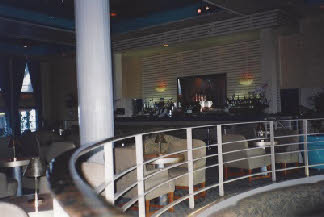
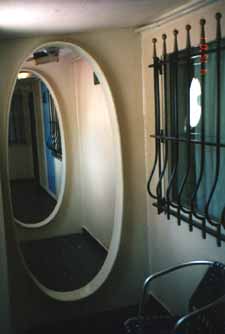
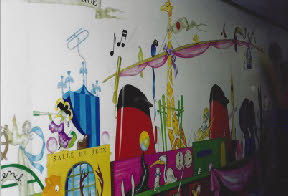
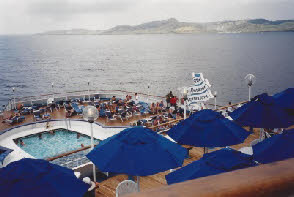
Top: left, Club Internationale; right, remnants of Courtyard Provençal
Bottom: left, Noah’s Ark mural in children’s playroom; right, aft pool and buffet
Her fate: SS Norway was removed from service in 2003 after a tragic boiler explosion that killed eight crew members soon after the ship arrived at her home port of Miami. Ownership transferred to Star Cruises in 2004, and a decision to sell her for scrap was made a year later. The scrapping process was complicated by the asbestos that was onboard. She was eventually sold in 2006 and renamed Blue Lady, and the scrapping took place in Alang, India from 2007 to 2009.
MS Regal Empress (2001)
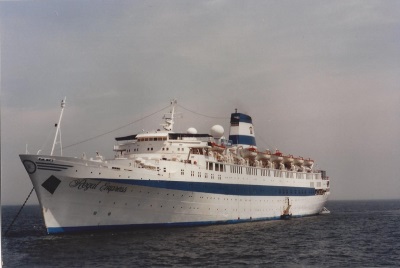
The Ship: Regal Empress was built in Glasgow, Scotland in 1953 as TSS Olympia, the first and only newbuild for the Greek Line. Olympia made regular transatlantic runs between the Mediterranean (Piraeus, Haifa) and New York, and was later used for cruising. She was withdrawn from service in 1974 and was laid up for the next seven years. She was rescued by Commodore Cruise Line in 1981, and renamed Caribe. Commodore made several alterations to prepare the ship for the growing Caribbean cruise industry – most notably, the conversion of her engines from steam turbine to diesel, a move that ultimately lengthened her career. In 1993, she was sold to Regal Cruises, where she served as Regal Empress until the line went out of business in 2003. At that time, she was sold to Imperial Majesty Cruises to replace OceanBreeze, her lower operating costs a determining factor. At the time of our sailing, she was a cozy 21,909 gross tons, measured 612 feet long, and carried a maximum of 1,068 passengers (934 double occupancy) and a crew of 396.
Our cruise: We were onboard in August 2001 for a five-
Memories: I fell in love with the ambiance of this ship soon after stepping onboard.
There was wood everywhere—on the decks, the walls, the doors, around the windows—giving
her a charming, old-
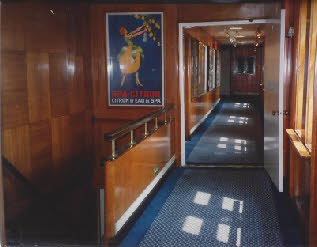
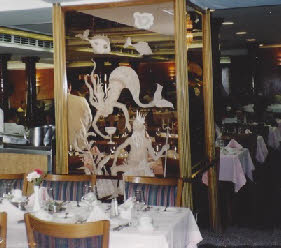
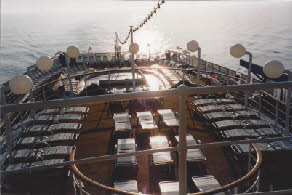
Top: left, one of many wood-
Bottom: cascading aft decks and pool
Her fate: Regal Empress was sold for scrap in 2009 and was dismantled in Alang, India from 2009 to 2010. Two of her stairwell panels now adorn the walls of my living room.
(All photographs are copyright NauticalNotebook.com and may be used with proper attribution.)




